 |
Convert EAC3 to AMR
|
Total Audio MP3 Converter converts EAC3 files to AMR format.
The software is an all in one audio converter that supports more than 90 audio
and video files as input, and converts to popular formats such as MP3, WAV, AAC,
M4A, OGG, WMA, and AMR.
Total Audio MP3 Converter also supports batch conversion, and is full compatible
with Vista and Windows 7.
- Free Download
Total Audio MP3 Converter here and then install the software
by instructions
- Launch Total Audio MP3 Converter
- Choose EAC3 Files
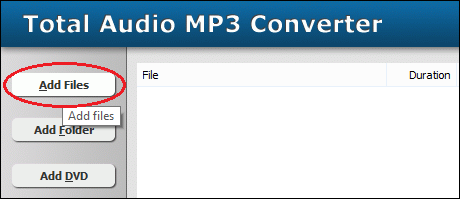
Click "Add Files" to choose EAC3 files and then add them to conversion
list.
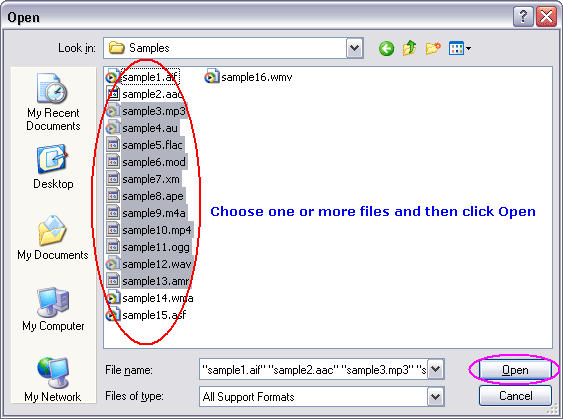
Choose one or more EAC3 files you want to convert and then click Open.
- Choose "to AMR"
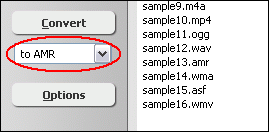
- Convert EAC3 to AMR

Click button "Convert" to convert EAC3 files to AMR format.
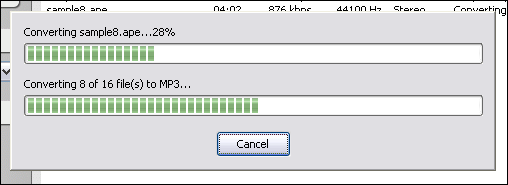
The software is converting EAC3 files to AMR format.
- Play and Browse AMR File
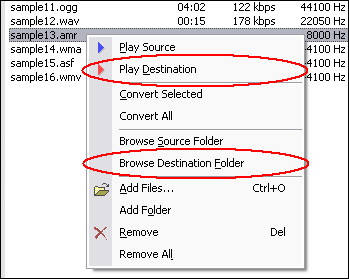
When conversion completes, you could right-click converted AMR file and choose
"Play Destination" to play the outputted AMR file; or choose "Browse
Destination Folder" to open Windows Explorer to browse the AMR file.
Top
What is EAC3?
Dolby Digital Plus (DD+ or E-AC-3 (Enhanced AC-3), and sometimes incorrectly as
EC-3) is a digital audio compression scheme. It is an incompatible[1] development
of the technologies used in the earlier Dolby Digital system. E-AC-3 has a number
of improvements aimed at increasing quality at a given bitrate compared with legacy
Dolby Digital (AC-3). While legacy AC-3 supports up to 5 full-range audio channels
at a coded bitrate of 0.640 Mbit/s, E-AC-3 supports up to 13 full range audio
channels at a coded bitrate of 6.144 Mbit/s peak.
Dolby Digital Plus bitstreams are not backward compatible with legacy Dolby
Digital decoders, and decoders that output audio over legacy S/PDIF connections
must transcode the bitstreams to an older format such as PCM, AC-3, or DTS.
The codec used by Dolby Digital Plus is based on the original Dolby Digital
codec, but with several enhancements to improve coding efficiency:
- Transient pre-noise processing - to reduce "pre-noise" artifacts
before sharp transients.
- Enhanced channel coupling - which maintains phase relationships between channels,
and improves performance of matrix decoders.
- Adaptive hybrid transform processing - an improved bit allocation and quantization
algorithm.
Dolby claims that these changes can result in bitrate improvements of up to
50% while still allowing for the signal to be efficiently converted to Dolby Digital
for backwards compatibility.
What is AMR?
Adaptive Multi-Rate (AMR) is an audio data compression scheme optimized for speech
coding. AMR was adopted as the standard speech codec by 3GPP in October 1998 and
is now widely used in GSM and UMTS. It uses link adaptation to select from one
of eight different bit rates based on link conditions. AMR is also a file format
for storing spoken audio using the AMR codec. Many modern mobile telephone handsets
will allow you to store short recordings in the AMR format. There also exists
another storage format for AMR that is suitable for applications with more advanced
demands on the storage format, like random access or synchronization with video.
This format is the 3GPP-specified 3GP container format based on ISO base media
file format.
Key Features:
- Sampling frequency 8 kHz/13-bit (160 samples for 20 ms frames), filtered to
200-3400 Hz.
- The AMR codec uses eight source codecs with bit-rates of 12.2, 10.2, 7.95,
7.40, 6.70, 5.90, 5.15 and 4.75 kbit/s.
- Generates frame length of 95, 103, 118, 134, 148, 159, 204, or 244 bits for
bit rates 4.75, 5.15, 5.90, 6.70, 7.40, 7.95, 10.2, or 12.2 kbit/s, respectively
- AMR utilizes Discontinuous Transmission (DTX), with Voice Activity Detection
(VAD) and Comfort Noise Generation (CNG) to reduce bandwidth usage during silence
periods
- Algorithmic delay is 20 ms per frame. For bit-rates of 12.2, there is no 'algorithm'
look-ahead delay. For other rates, look-ahead delay is 5 ms. Note that there is
5 ms 'dummy' look-ahead delay, to allow seamless frame-wise mode switching with
the rest of rates.
- AMR is a hybrid speech coder which uses Algebraic Code Excited Linear Prediction
(ACELP)
- The complexity of the algorithm is rated at 5, using a relative scale where
G.711 is 1 and G.729a is 15.
- PSQM testing under ideal conditions yields Mean Opinion Scores of 4.14 for
AMR (12.2 kbit/s), compared to 4.45 for G.711 (u-law)
- PSQM testing under network stress yields Mean Opinion Scores of 3.79 for AMR
(12.2 kbit/s), compared to 4.13 for G.711 (u-law)
Convert EAC3 to AMR Related Topics:
PSX to AMR,
MTV to AMR,
NSA to AMR,
QCP to AMR,
MP1 to AMR,
MPP to AMR,
ROQ to AMR,
XA to AMR,
DRC to AMR,
MKV to AMR,
DV to AMR,
MP2 to AMR,
GXF to AMR,
MTS to AMR,
MPG to AMR,
ULAW to AMR,
MXF to AMR,
VOB to AMR,
VFW to AMR,
QT to AMR,
EVOB to AMR,
DTS to AMR,
OGV to AMR,
SDP to AMR,
HDTV to AMR,
3GPP to AMR,
M2V to AMR,
WM to AMR,
SMK to AMR,
MMF to AMR,
NSV to AMR,
NUT to AMR,
THD to AMR,
3G2 to AMR,
AVI to AMR,
M1A to AMR,
M4R to AMR,
FLIC to AMR,
WAVE64 to AMR,
F4A to AMR
|






